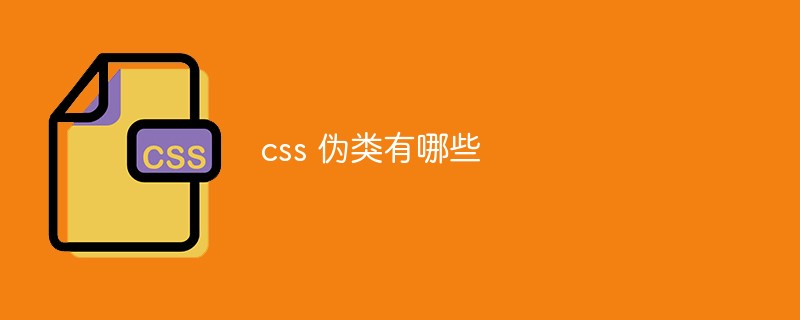Home >Web Front-end >CSS Tutorial >What are the css pseudo-classes?
What are the css pseudo-classes?
- 青灯夜游Original
- 2021-07-06 16:50:168901browse
css pseudo-classes include: ":link", ":visited", ":hover", ":active", ":focus", ":lang()", "not()", " :root", ":first-child", ":last-child", ":empty" and so on.

The operating environment of this tutorial: Windows 7 system, CSS3 version, Dell G3 computer.
CSS pseudo-classes are used to add some special effects of selectors. They are used to add corresponding styles to existing elements when they are in a certain state. This state changes dynamically based on user behavior.
For example: when the user hovers over a specified element, you can use :hover to describe the state of this element. Although it is similar to general CSS and can add styles to existing elements, it can only be in the DOM tree. Styles can be added to elements only in the described state, so they are called pseudo-classes.
It feels like pseudo-classes can be dynamic, and an element can gain or lose a pseudo-class when the user interacts with the document. The exceptions are ":first-child" which can be inferred from the document tree, and ":lang" which is also inferred from the document tree in some cases.
It can be seen that its function is somewhat similar to class, but it is based on abstraction outside of the document, so it is called a pseudo class.
css pseudo-class selector list
| Properties Properties |
CSS Version Version |
Inherit From Parent Inheritance |
Description Introduction |
|---|---|---|---|
| E:link | CSS1 | None | CSS1 pseudo-class selector E:link, set the style of hyperlink a before it is visited. |
| E:visited | CSS1 | None | CSS1 pseudo-class selector E:visited, set the hyperlink a in it The link address has been accessed in an outdated style. |
| E:hover | CSS2 | None | CSS2/CSS1 pseudo-class selector E:hover, set the element in it Style on mouseover. |
| E:active | CSS2/CSS1 | None | CSS2/CSS1 pseudo-class selector E:active, set element Style when activated by the user (an event that occurs between mouse click and release). |
| E:focus | CSS2/CSS1 | None | CSS2/CSS1 pseudo-class selector E:focus, set element Style when input focus occurs (the element's onfocus event occurs). |
| E:lang() | CSS2 | None | CSS2 pseudo-class selector E:lang() matches using special E element of language. |
| E:not() | CSS3 | None | CSS3 pseudo-class selector E:not() matches does not contain The element E of the s selector. |
| E:root | CSS3 | None | CSS3 pseudo-class selector E:root, matches the E element in the document root element. |
| E:first-child | CSS2 | None | CSS2 pseudo-class selector E:first-child matches the parent element The first child element E. |
| E:last-child | CSS3 | None | CSS3 pseudo-class selector E:last-child matches the parent element The last child element E. |
| E:only-child | CSS3 | None | CSS3 For example, the selector E:only-child matches the parent element The only child element E. |
| E:nth-child(n) | CSS3 | None | CSS3 pseudo-class selector E:nth-child (n) Matches the nth child element E of the parent element. |
| E:nth-last-child(n) | CSS3 | None | CSS3 pseudo-class selector E:nth -last-child(n) matches the nth child element E from the bottom of the parent element. |
| E:first-of-type | CSS2 | None | CSS3 pseudo-class selector E:first-of- type matches the first sibling element E of the same type. |
| E:last-of-type | CSS3 | None | CSS3 pseudo-class selector E:last-of- type matches the last sibling element E of the same type. |
| E:only-of-type | CSS3 | None | CSS3 pseudo-class selector E:only-of- type, matches the only sibling element E of the same type. |
| E:nth-of-type(n) | CSS3 | None | CSS3 pseudo-class selector E:nth -of-type(n), matches the nth sibling element E of the same type. |
| E:nth-last-of-type(n) | CSS3 | None | CSS3 pseudo-class selector E :nth-last-of-type(n) matches the penultimate nth sibling element E of the same type. |
| E:empty | CSS3 | None | CSS3 pseudo-class selector E:empty matches no child elements (including text node) element E. |
| E:checked | CSS3 | None | CSS3 pseudo-class selector E:checked matches the selected state on the user interface The element E. (For form elements with input type of radio and checkbox) |
| E:enabled | CSS3 | None | CSS3 Pseudo The class selector E:enabled matches the element E in the enabled state on the user interface. |
| E:disabled | CSS3 | None | CSS3 pseudo-class selector E:disabled matches the disabled state on the user interface The element E. |
| E:target | CSS3 | None | CSS3 pseudo-class selector E:target matches the E element pointed to by the relevant URL . |
| @page:first | CSS2 | None | CSS2 pseudo-class selector @page:first sets the page container first The style used by the page. Only used for @page rules |
| @page:left | CSS2 | None | CSS2 pseudo-class selector @page: left sets the style used by all pages whose page container is located to the left of the gutter. Only used for @page rules |
| @page:right | CSS2 | None | CSS2 is the object selector @page: right sets the style used for all pages whose page container is located to the right of the gutter. Only used for @page rules |
(Learning video sharing: css video tutorial)
The above is the detailed content of What are the css pseudo-classes?. For more information, please follow other related articles on the PHP Chinese website!
Related articles
See more- A brief discussion on the similarities and differences between the css perspective attribute and the perspective() function
- What is the CSS motion path module? How to animate motion paths?
- An in-depth analysis of the css text-emphasis property and its usage!
- 26 CSS interview questions worth collecting to enhance your CSS foundation!
- What is :placeholder-shown in CSS? how to work? What is the use?

